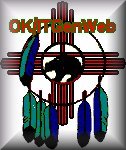  |
Okfuskee County |
  |
|
Home |
Archives |
Cemeteries |
Obits
| Queries
| Additional
Links |
||
  |
Okfuskee County |
  |
|
Home |
Archives |
Cemeteries |
Obits
| Queries
| Additional
Links |
||
Okemah, now a community of 3,500 population in east central Oklahoma, was officially opened for settlement April 22, 1902, exactly five years to the day before Oklahoma achieved statehood.
That day was one of bustling activity for Okemah. A historian of the community, the late W. H. Dill, wrote in the late 1930s that the crowd on the day the lots were sold "was perhaps larger than on any other occasion since the beginning of the town, except possibly the homecoming of Leon C. Phillips, our townsman, who has been elected governor of the state of Oklahoma.
Dill was one of the founders of the community, having previously aided in the platting of the townsite for Shawnee. This gentleman was drawn to this area by colorful newspaper accounts regarding the fabulous wealth of Oklahoma ranchers.
The founders planned the Town Site where they understood two proposed railroads would later intersect. One, the Fort Smith and Western, did build through town but the other, the Frisco, was routed several miles south. This factor was a source of discouragement to the planners. The FS&W failed in 1930, leaving Okemah without a railroad.
Named for a Kickapoo Indian chieftain, Okemah did not immediately attain the dignity of a chief. Early day newspapers indicate the community had a good deal of the flavor of the wild and woolly West. Headlines reported such events as a chase for runaway couples, apprehension of cattle rustlers, shooting scrapes and the like.
King Cotton began an early reign in the Okemah area. The area was primarily agricultural and cotton was the chief crop. Cotton gins sprung up all over Okfuskee County. Today only two remain. Cotton production is only a fraction of what it once was.
In the mid-1920s Okemah became a boom town. Located on the edge of the great Cromwell field, the town mushroomed to a population conservatively estimated at 7,000 persons. Oil gushed from the ground and oil money flowed. The history of oil booms is not new to Oklahoma. The prosperity they produce is impermanent.
Weathering the Depression, the community was on the receiving end of a serious of make-work projects of the Roosevelt administration. New library and school buildings were constructed and a sports stadium was built. A lake also was a public works project. A new post office was dedicated in 1936.
About this time Okemah began a series of birthday celebrations, staging a big event on each April 22. Screen stars were brought in for the festivities. A parade, rodeo and other activities were scheduled each year. Crowds came to Okemah each year to attend. This practice was discontinued during the war years and not resumed with any consistency since. The last celebration was in 1952, the golden anniversary.
Recent progress in Okemah is indicated by the approval of a $200,000 bond issue for water development. Okemah has a new swimming pool and recreation building, as well as a new gymnasium auditorium.
Okemahns are active in trying to attract industry in an effort to balance
the sagging drought-stricken agricultural economy. They look to the future
with hope.
This page was last updated on 10/12/11
Oklahoma Family Group
Sheets |
OK Gen Web |
County Coordinator Linda Simpson
